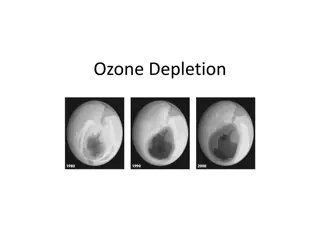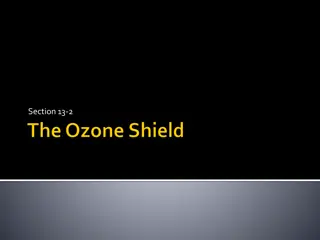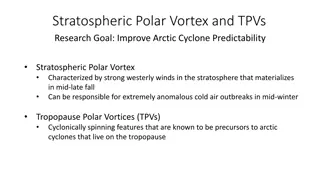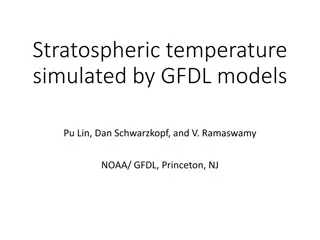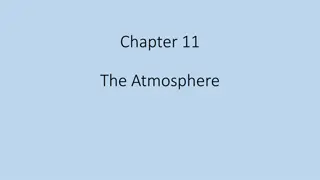An overview of solar influence on climate
The relationship between solar variability and Earth's climate is complex, with factors like the Sun's energy output, 11-year solar cycle, and regional differences playing a role. This overview delves into how solar influences interact with atmospheric and oceanic processes, such as the Sun's impact
6 views • 37 slides
Understanding Ozone Depletion: Causes and Impact
The ozone layer, found in the stratosphere at 15 to 40 km altitude, plays a crucial role in absorbing harmful ultraviolet radiation. However, due to the use of Chlorofluorocarbons (CFCs), the ozone layer has been depleted, leading to the formation of the ozone hole. This depletion is caused by chemi
0 views • 27 slides
Understanding Chemistry and Composition in the Climate System
Dive into the intricate relationship between chemistry and composition in the climate system, exploring topics such as radiative effects, stratosphere-troposphere coupling, aerosol-cloud interactions, and the impact of various gases and particulates on radiative forcing. Discover how changes in comp
0 views • 25 slides
Understanding Ozone Depletion and Its Impact on the Environment
The stratosphere contains a vital layer of ozone that shields the Earth from harmful UV radiation. However, human activities, particularly the use of chlorofluorocarbons (CFCs), have led to the depletion of this protective ozone layer, especially over the poles. This thinning of ozone poses signific
0 views • 10 slides
Understanding Transport Timescales and Source Regions of UTLS Air
Complex mixtures of air in the Upper Troposphere and Lower Stratosphere (UTLS) are studied using in situ trace gas measurements from the START08 campaign and surface stations. This research aims to determine transport timescales and source regions of air in the extratropical UTLS, focusing on high a
0 views • 11 slides
Research on Stratospheric Polar Vortex and TPVs for Arctic Cyclone Predictability
This research aims to enhance predictability of Arctic cyclones by studying the Stratospheric Polar Vortex and Tropopause Polar Vortices (TPVs). The presence of strong westerly winds in the stratosphere during fall leads to anomalous cold air outbreaks in mid-winter. TPVs serve as precursors to arct
0 views • 4 slides
Simulation of Stratospheric Temperature by GFDL Models: Observations and Trends
Interannual variations of stratospheric temperature since 1979 are well simulated by GFDL models, showing general cooling trends, stronger cooling over Southern Hemisphere high latitudes, post-eruption warming, delayed cooling after eruptions, and flat trends in the 2000s. However, models tend to ov
0 views • 10 slides
Understanding Earth's Atmosphere Composition and Layers
Earth's atmosphere is primarily composed of nitrogen and oxygen, with other gases like argon, CO2, and water vapor making up the remaining percentage. While the levels of nitrogen and oxygen remain constant, variable gases like water vapor fluctuate based on location and time. CO2 levels have been i
0 views • 53 slides

